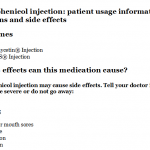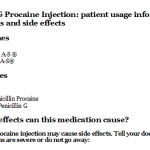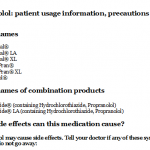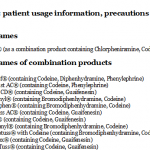
MMR II: Measles, Mumps, and Rubella Virus Vaccine Live: patient information, prescribing information, ingredients, manufacturer, adverse reactions and side effects
Thursday, April 06, 2017 by Gregory Van Dyke
http://www.naturalnewsreference.com/2017-04-06-mmr-ii-measles-mumps-and-rubella-virus-vaccine-live-patient-information-prescribing-information-ingredients-manufacturer-adverse-reactions-and-side-effects.html

HIGHLIGHTS OF PRESCRIBING INFORMATION
These highlights do not include all the information needed to use M-M-R II safely and effectively. See full prescribing information for M-M-R II.
See full insert sheet at this link at the Natural News Reference website.
M-M-R II (Measles, Mumps, and Rubella Virus Vaccine, Live)
SUBCUTANEOUS ADMINISTRATION
Initial US Appoval:
INGREDIENTS AND EXCIPIENTS
M-M-R® II (Measles, Mumps, and Rubella Virus Vaccine Live) is a live virus vaccine for vaccination against measles (rubeola), mumps, and rubella (German measles).
M-M-R II is a sterile lyophilized preparation of (1) ATTENUVAX® (Measles Virus Vaccine Live), a more attenuated line of measles virus, derived from Enders’ attenuated Edmonston strain and propagated in chick embryo cell culture; (2) MUMPSVAX® (Mumps Virus Vaccine Live), the Jeryl Lynn™ (B level) strain of mumps virus propagated in chick embryo cell culture; and (3) MERUVAX® II (Rubella Virus Vaccine Live), the Wistar RA 27/3 strain of live attenuated rubella virus propagated in WI-38 human diploid lung fibroblasts.{1,2}
The growth medium for measles and mumps is Medium 199 (a buffered salt solution containing vitamins and amino acids and supplemented with fetal bovine serum) containing SPGA (sucrose, phosphate, glutamate, and recombinant human albumin) as stabilizer and neomycin.
The growth medium for rubella is Minimum Essential Medium (MEM) [a buffered salt solution containing vitamins and amino acids and supplemented with fetal bovine serum] containing recombinant human albumin and neomycin. Sorbitol and hydrolyzed gelatin stabilizer are added to the individual virus harvests.
The cells, virus pools, and fetal bovine serum are all screened for the absence of adventitious agents.
The reconstituted vaccine is for subcutaneous administration. Each 0.5 mL dose contains not less than 1,000 TCID50 (tissue culture infectious doses) of measles virus; 12,500 TCID50 of mumps virus; and 1,000 TCID50 of rubella virus. Each dose of the vaccine is calculated to contain sorbitol (14.5 mg), sodium phosphate, sucrose (1.9 mg), sodium chloride, hydrolyzed gelatin (14.5 mg), recombinant human albumin (≤0.3 mg), fetal bovine serum (<1 ppm), other buffer and media ingredients and approximately 25 mcg of neomycin. The product contains no preservative.
Before reconstitution, the lyophilized vaccine is a light yellow compact crystalline plug. M-M-R II, when reconstituted as directed, is clear yellow.
INDICATIONS AND USAGE
M-M-R II is indicated for simultaneous vaccination against measles, mumps, and rubella in individuals 12 months of age or older.
DOSAGE AND ADMINISTRATION
– FOR SUBCUTANEOUS ADMINISTRATION
– Do not inject intravascularly.
– The dose for any age is 0.5 mL administered subcutaneously, preferably into the outer aspect of the upper arm.
– The recommended age for primary vaccination is 12 to 15 months.
DOSAGE FORMS AND STRENGTHS
M-M-R II is supplied as follows:
(1) a box of 10 single-dose vials of lyophilized vaccine (package A), NDC 0006-4681-00; and (2) a box of 10 vials of diluent (package B). To conserve refrigerator space, the diluent may be stored separately at room temperature.
CONTRAINDICATIONS
Hypersensitivity to any component of the vaccine, including gelatin.{40}
Do not give M-M-R II to pregnant females; the possible effects of the vaccine on fetal development are unknown at this time. If vaccination of postpubertal females is undertaken, pregnancy should be avoided for three months following vaccination (see INDICATIONS AND USAGE, Non-Pregnant Adolescent and Adult Females and PRECAUTIONS, Pregnancy).
Anaphylactic or anaphylactoid reactions to neomycin (each dose of reconstituted vaccine contains approximately 25 mcg of neomycin).
WARNINGS AND PRECAUTIONS
Due caution should be employed in administration of M-M-R II to persons with a history of cerebral injury, individual or family histories of convulsions, or any other condition in which stress due to fever should be avoided. The physician should be alert to the temperature elevation which may occur following vaccination (see ADVERSE REACTIONS).
Hypersensitivity to Eggs, Hypersensitivity to Neomycin, Thrombocytopenia
ADVERSE REACTIONS
Patients, parents, or guardians should be instructed to report any serious adverse reactions to their health-care provider who in turn should report such events to the U.S. Department of Health and Human Services through the Vaccine Adverse Event Reporting System (VAERS), 1-800-822-7967.{49}
Pregnancy should be avoided for 3 months following vaccination, and patients should be informed of the reasons for this precaution.
USE IN SPECIFIC POPULATIONS
Pregnancy
Pregnancy Category C: Animal reproduction studies have not been conducted with M-M-R II. It is also not known whether M-M-R II can cause fetal harm when administered to a pregnant woman or can affect reproduction capacity. Therefore, the vaccine should not be administered to pregnant females; furthermore, pregnancy should be avoided for 3 months following vaccination (see INDICATIONS AND USAGE, Non-Pregnant Adolescent and Adult Females and CONTRAINDICATIONS).
In counseling women who are inadvertently vaccinated when pregnant or who become pregnant within 3 months of vaccination, the physician should be aware of the following: (1) In a 10-year survey involving over 700 pregnant women who received rubella vaccine within 3 months before or after conception (of whom 189 received the Wistar RA 27/3 strain), none of the newborns had abnormalities compatible with congenital rubella syndrome;{50} (2) Mumps infection during the first trimester of pregnancy may increase the rate of spontaneous abortion. Although mumps vaccine virus has been shown to infect the placenta and fetus, there is no evidence that it causes congenital malformations in humans;{37} and (3) Reports have indicated that contracting wild-type measles during pregnancy enhances fetal risk. Increased rates of spontaneous abortion, stillbirth, congenital defects and prematurity have been observed subsequent to infection with wild-type measles during pregnancy.{51,52} There are no adequate studies of the attenuated (vaccine) strain of measles virus in pregnancy. However, it would be prudent to assume that the vaccine strain of virus is also capable of inducing adverse fetal effects.
Nursing Mothers
It is not known whether measles or mumps vaccine virus is secreted in human milk. Recent studies have shown that lactating postpartum women immunized with live attenuated rubella vaccine may secrete the virus in breast milk and transmit it to breast-fed infants.{53} In the infants with serological evidence of rubella infection, none exhibited severe disease; however, one exhibited mild clinical illness typical of acquired rubella.{54,55} Caution should be exercised when M-M-R II is administered to a nursing woman.
Pediatric Use
Safety and effectiveness of measles vaccine in infants below the age of 6 months have not been established (see also CLINICAL PHARMACOLOGY). Safety and effectiveness of mumps and rubella vaccine in infants less than 12 months of age have not been established.
Geriatric Use
Clinical studies of M-M-R II did not include sufficient numbers of seronegative subjects aged 65 and over to determine whether they respond differently from younger subjects. Other reported clinical experience has not identified differences in responses between the elderly and younger subjects.
Revised:
https://www.fda.gov/BiologicsBloodVaccines/Vaccines/ApprovedProducts/ucm094050.htm
Tagged Under: Tags: dosage, ingredients, insert sheet, MMR II, side effects, usage, warnings





